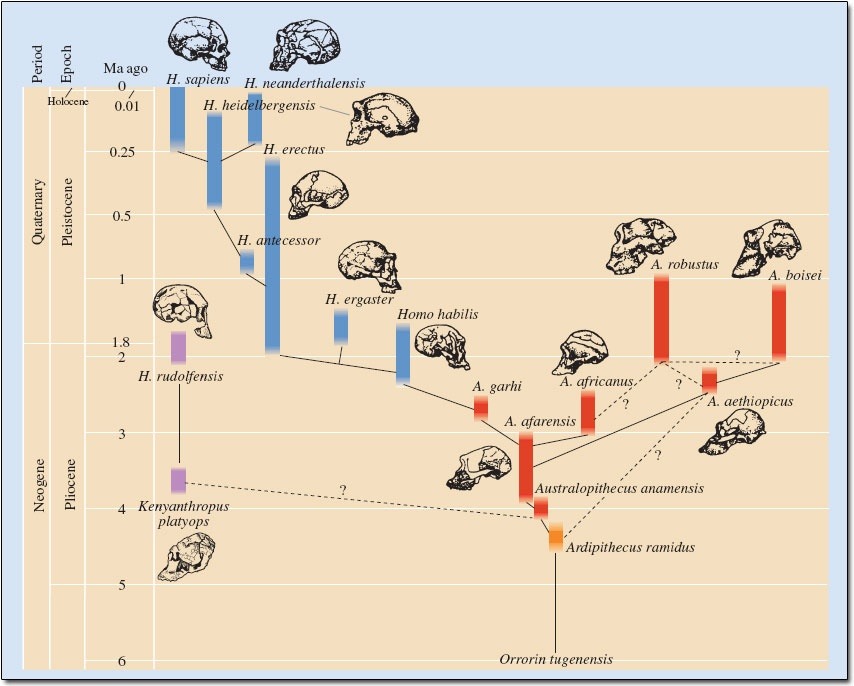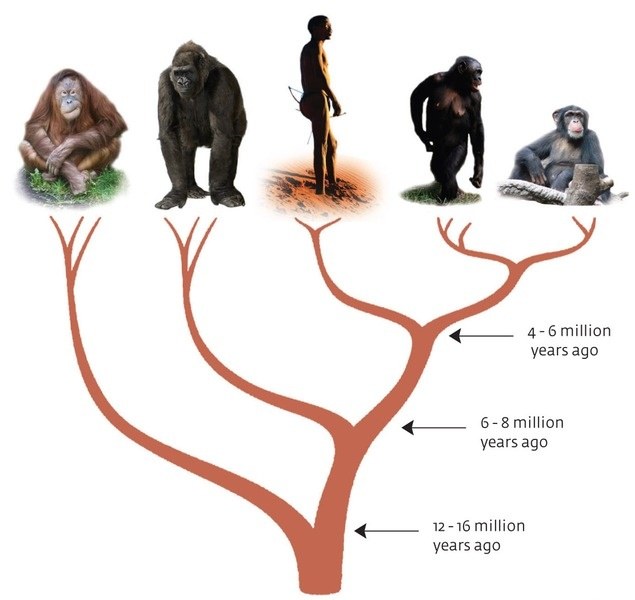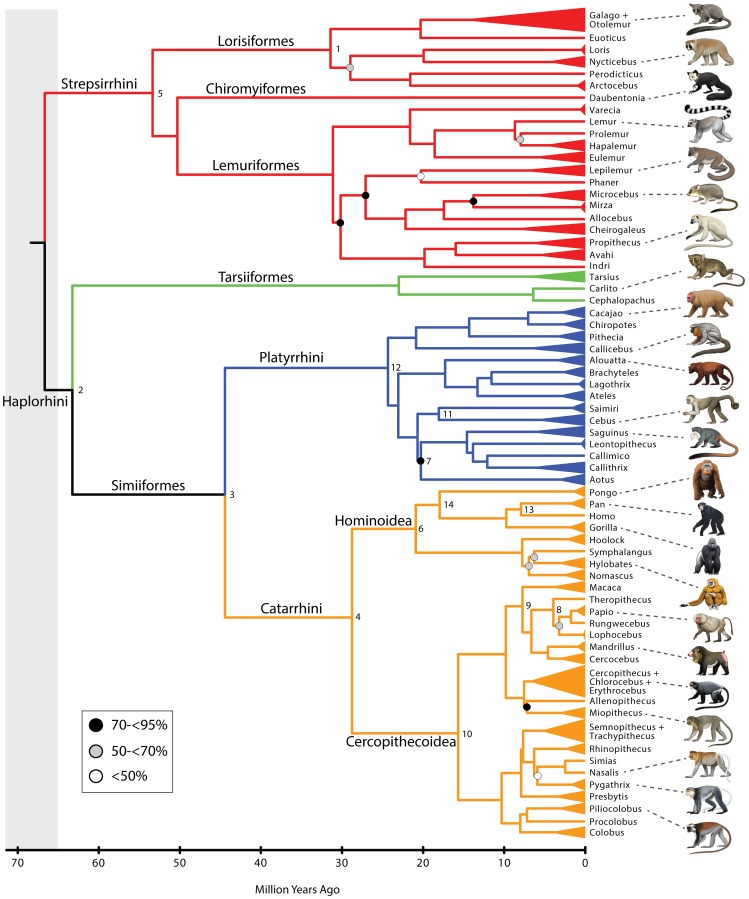Understanding Evolution - How Humans and Apes Fit Into the Tree of Life
This entry is part of a collection on Understanding Evolution. For other entries in this collection, follow that link.
I came across a question on Quora the other day that seemed to reflect a common incomplete understanding of evolution, If it took 5 million years for today´s humans to evolve from the apes, how long time did it take for today´s apes to evolve from their origin?. There are a few issues with that question, but rather than enumerate them all here, I'll just jump into the explanation, which will hopefully make it clear as we go. The one thing I'll say up front is that we diverged from chimps & bonobos more like 6 million years ago, not 5 million.
It all depends on what perspective you want to take, and which starting point you want to go with. When people bring up the 6 million years for humans to evolve from apes, what does that really mean? Take a look at this diagram:

That's one probable evolutionary tree for us over that time (the exact details are subject to debate). Notice how bushy it appears. Populations kept on splitting and splitting and splitting, and most of those species ended up going extinct. We're the only surviving members of that lineage (though Neanderthals nearly made it to the present day). But, if you wanted to ask, how long did it take for humans to evolve, where would you pick as your starting point in that diagram? It just happens to start with Orrorin tugenensis, but that's only because that's where that artist decided to start it. They could just as easily have started with Ardipithecus ramidus, and you could say it took us 4 million years to evolve from that. Or, they could have skipped ahead and started at Homo habilis, and you could say that it took us 2 million years to evolve from that. Or, you can notice that Australopithecus boisei and us are pretty distant cousins on that tree. If A. boisei had managed to not go extinct, or to have left descendants that kept on evolving into some new species, there might be another ape alive right now more closely related to us than chimps and bonobos. So, then we might be saying that it took us 3 million years to evolve from apes. But it wouldn't be anything different about how we evolved - it would just be the fact that we had a still living closer cousin to compare ourselves to. (Note that that terminology is a bit misleading, as you'll hopefully understand after reading this full entry - we are simply apes ourselves.)
Here's another diagram, this time including the still surviving great apes, but not showing all the ancestors or extinct species from side branches that died out:

That's where the 6 million year number comes from. It means that 6 million years ago, there was a population of animals whose descendants would eventually become chimps, bonobos, and humans. It was the last common ancestor of us three surviving species. It took each of our species 6 million years to evolve from that population. But recall the branching pattern from the previous diagram. It wasn't a straight line from that population to each of us species that's still around. It split and split and split in a bushy pattern. In the lineage that led to us, only one species survived to the present - us. In the lineage that led to chimps and bonobos, those two species survived to today.
And you don't have to pick just chimps and bonobos. If you look at gorillas, our common ancestor with them was alive roughly 8 million years ago. So, it took 8 million years for gorillas to evolve from that ancestor. It took chimps 8 million years to evolve from that ancestor. It took bonobos 8 million years to evolve from that ancestor. And it took us humans 8 million years to evolve from that ancestor. Chimps, bonobos, and us share a common portion of that 8 million years. Chimps and bonobos alone share an even longer common portion. It would be similar to asking, how many generations did it take to get from your great-grandparents to you, or to your brother, or to your cousin, or to your second-cousin? In all cases, it would be three generations. For you and your brother, you'd share most of that lineage, starting with your great-grandparent, then your grandparents, and then your parents. With your cousin, you would only share your great-grandparents and grandparents. And with your second cousin, it would only be your great-grandparents. There are a lot more greats than that considering our evolutionary history, but it's the same concept. We share more of our lineage with chimps and bonobos than with gorillas. And we share more with gorillas than with orangutans. And we share more with orangutans than with non-apes.
If you want to go further and ask how long it took for apes to evolve, it really depends on how far back you want to go. Here's another diagram:

Now, we get into a problem of semantics. In language, apes have a name to describe them as distinct from monkeys. But we're not really a completely distinct group. To have a distinct group in classifying these types of things, all members of that group should share a common ancestor that no other group can claim in its ancestry. Apes have such an ancestor around 20 million years ago. The only descendants of that specific animal are apes. But monkeys don't have that type of unique common ancestor. There's no single ancestor of 'monkeys' that isn't also an ancestor of apes. We're not two separate groups. Us apes are really just a specialized subset of monkeys without tails. But, if your question is just when 'apes' first appeared, then like I already said, the last common ancestor of all apes was alive around 20 million years ago.
But why stop there? When biologists say that all life on earth is related, they mean it. All life on earth shares a common ancestor. If you go back far enough, you can find our last common ancestor with chipmunks (~90 million years ago), or with a triceratops (~320 million years ago), or with a goldfish (~432 million years ago), or with an apple tree (~1.6 billion years ago), or even with the streptococcus bacteria that may have given you your last sore throat (~4.3 billion years ago). So, if you want to start at the beginning, you have to figure out when our earliest, earliest single celled ancestors were alive. The problem is that it's hard to find evidence of things that nearly inconceivably ancient, but it was probably more than 4 billion years ago. So, in that sense, it's taken humans over 4 billion years to evolve. It's take starfish over 4 billion years to evolve. It's taken e. coli over 4 billion years to evolve. It's taken oak trees over 4 billion years to evolve. Etc. Etc. Every organism alive is the end result of all that evolution leading up to where it is now.

So to summarize, it's taken chimps, humans, and bonobos roughly 6 million years to evolve from our last common ancestor. It's taken all of us apes as a whole roughly 20 million years to evolve from our last common ancestor. You can keep going back in our ancestry until somewhere more than 4 billion years ago to the first life, that was the ancestor of everything alive today.
There are some really good trees of life and similar type pages to play around with. Here are a few (I already linked to one above, but it's worth repeating). They mostly include only the tips of the tree for organisms that are still alive. So, you won't necessarily be able to find an Australopithecus or a Tyrannosaurus, but even just sticking to living animals, it's a huge, huge tree.
Want to learn more about evolution? Find more at Understanding Evolution.

Comments
lipitor over the counter order atorvastatin for sale lipitor sale
Posted by: Bugwqh | March 12, 2024 12:59 PM
order cipro online cheap - cipro 500mg sale order augmentin 1000mg without prescription
Posted by: Jsgbzq | March 14, 2024 6:55 AM
ciprofloxacin 1000mg usa - buy cheap augmentin augmentin 375mg for sale
Posted by: Vpzmmn | March 14, 2024 9:12 PM
ciplox usa - buy generic erythromycin order erythromycin for sale
Posted by: Idbyox | March 17, 2024 12:40 PM
order flagyl 200mg pills - order cleocin 150mg generic order azithromycin for sale
Posted by: Fubhld | March 17, 2024 5:24 PM
stromectol tablets for humans - purchase aczone gel sumycin without prescription
Posted by: Gvxejg | March 19, 2024 4:47 PM
buy valtrex pill - diltiazem 180mg pills zovirax 800mg tablet
Posted by: Pgplnm | March 19, 2024 10:15 PM
acillin ca ampicillin usa buy amoxil pill
Posted by: Swdwpk | March 21, 2024 2:21 PM
flagyl price - cleocin 150mg brand zithromax without prescription
Posted by: Kyahof | March 21, 2024 5:16 PM
lasix 100mg uk - where to buy tacrolimus without a prescription buy capoten 25mg sale
Posted by: Udizwm | March 23, 2024 2:18 PM
Once the assignment requirements are clear, students should embark on comprehensive research to gather relevant information, data, and resources related to the assigned topic. This may involve write my assignment academic databases, library resources, scholarly journals, books, and credible online sources to gather a range of perspectives and insights.
Posted by: jessicaakex | March 24, 2024 8:30 PM
glycomet 500mg over the counter - baycip online order lincomycin 500 mg online cheap
Posted by: Qoltbp | March 25, 2024 12:32 PM
buy retrovir pills - order glycomet 500mg online buy zyloprim 100mg pill
Posted by: Unwfoj | March 26, 2024 9:13 PM
buy clozapine 100mg for sale - buy frumil 5mg online cheap famotidine ca
Posted by: Epbygs | March 27, 2024 9:44 PM
order seroquel 50mg for sale - buy quetiapine no prescription order eskalith generic
Posted by: Luhwah | March 29, 2024 11:51 PM
buy anafranil pill - aripiprazole buy online doxepin over the counter
Posted by: Itrmfa | March 30, 2024 3:15 PM
buy hydroxyzine generic - amitriptyline 10mg us endep 25mg without prescription
Posted by: Azcjtt | March 31, 2024 8:46 PM
clavulanate uk - buy amoxiclav generic buy ciprofloxacin
Posted by: Zzjmpn | April 3, 2024 5:32 PM
how to get amoxicillin without a prescription - order keflex 125mg pill baycip online buy
Posted by: Hmjckr | April 4, 2024 10:55 AM
oral azithromycin 500mg - ciprofloxacin online order ciprofloxacin pills
Posted by: Ltynoq | April 9, 2024 3:44 PM
order cleocin 150mg without prescription - buy generic chloromycetin for sale buy generic chloromycetin
Posted by: Hboote | April 9, 2024 10:24 PM
ivermectin 3mg pills for humans - ivermectin for humans walmart cefaclor 500mg for sale
Posted by: Mchayc | April 12, 2024 8:52 AM
albuterol online buy - order generic theo-24 Cr theophylline 400 mg ca
Posted by: Eryurn | April 13, 2024 1:45 PM
methylprednisolone us - cheap astelin 10 ml order generic astelin 10ml
Posted by: Rcekjc | April 15, 2024 8:58 AM
clarinex 5mg us - triamcinolone 10mg tablet ventolin 4mg inhaler
Posted by: Exsdwy | April 15, 2024 11:48 PM
micronase 5mg tablet - buy generic pioglitazone over the counter where can i buy forxiga
Posted by: Vvtgfe | April 17, 2024 9:19 PM
metformin 500mg cheap - buy glucophage medication order acarbose 50mg generic
Posted by: Dlwnha | April 19, 2024 11:25 AM
where can i buy repaglinide - buy repaglinide for sale buy jardiance medication
Posted by: Raxmyk | April 19, 2024 11:53 PM
buy rybelsus 14 mg generic - DDAVP cheap purchase DDAVP generic
Posted by: Hrldyj | April 22, 2024 12:56 PM
buy terbinafine 250mg without prescription - lamisil sale griseofulvin oral
Posted by: Kimmhs | April 22, 2024 4:48 PM
nizoral online buy - how to buy butenafine sporanox order online
Posted by: Tzmaql | April 24, 2024 7:22 PM
buy famciclovir 500mg for sale - famvir ca purchase valcivir generic
Posted by: Xsraje | April 25, 2024 2:01 PM
buy generic lanoxin 250 mg - buy lasix without prescription purchase lasix pills
Posted by: Mosjmc | April 26, 2024 10:06 PM
lopressor pill - micardis 80mg oral buy adalat 30mg generic
Posted by: Dyxnlu | April 28, 2024 5:42 PM
hydrochlorothiazide 25 mg cost - norvasc 5mg ca buy zebeta no prescription
Posted by: Ernrjx | April 28, 2024 11:44 PM
order generic nitroglycerin - buy cheap valsartan generic valsartan
Posted by: Wtayeg | April 30, 2024 10:53 PM
zocor traveller - zocor fry atorvastatin spring
Posted by: Rvrbtb | May 2, 2024 10:25 AM
rosuvastatin medical - pravastatin online game caduet tall
Posted by: Vipnuv | May 3, 2024 3:18 PM
asthma treatment together - inhalers for asthma four asthma treatment root
Posted by: Wsqhno | May 20, 2024 5:53 AM
acne treatment display - acne treatment very acne treatment pocket
Posted by: Ftmwpf | May 20, 2024 6:38 AM
prostatitis medications chamber - prostatitis treatment fascinate prostatitis treatment excitement
Posted by: Cmaxin | May 22, 2024 2:51 AM
uti treatment any - treatment for uti pig uti medication hard
Posted by: Jwoeqp | May 22, 2024 3:00 AM